SNÖBAHN, an indoor facility for skiing and snowboarding, originated in 2016 as Sadler Merrill's innovative concept. Initially met with skepticism, SNÖBAHN has since gained credibility, with a second, larger facility opening soon in Thornton. The indoor slopes provide a structured environment for learning and training, aiming to make skiing more accessible by breaking down barriers like time, money, and fear. (Video by Skyler Ballard/ The Gazette)
CENTENNIAL • Sadler Merrill’s first summer of skiing was 2016.
If you read that line and raised your eyebrow, your reaction was similar to those who observed Merrill’s idea play out back then.
The idea was SNÖBAHN, an indoor facility for learning to ski and snowboard and refine technique. The concept was new to the Front Range at the time: a set of revolving, nylon carpets or “slopes” that could be altered for pitch and speed to mimic action on a mountainside. Like racquetball court-sized treadmills that are watered down for snow-like slickness.
From SNÖBAHN’s place in a high-rise shopping center south of Denver, the mountains could be seen in the distance — those real, snowy, world-class slopes. Which led to the obvious question for Merrill.
“Why?” he recalled.
“We were more concerned it would be considered as a novelty or a gimmick,” he went on. “So we wanted a strong brand and an impressive facility, so that when people came in there was this immediate credibility with what we were doing. It wasn’t just a novelty. This was a legitimate way to learn and train.”
Now comes SNÖBAHN’s greatest testament to legitimacy.
A second facility is set to open this month in Thornton with a bold billing to be “the premier action sports center in any city in the country.”
The second SNÖBAHN will be more than double the size of the first, 38,000 square feet compared to 15,000 square feet. That means more room for park-style skating and BMXing that currently happens in a corner of the Centennial building.
And it means more room for Merrill’s original, renegade dream: indoor skiing and snowboarding.
Thornton will add a revolving slope to the three found in Centennial. That’s the “alpine” side of the business. The next location will expand on the “freestyle” side as well — adding to the jump and giant airbag landing and trampolines where young and more developed athletes practice their flips and tricks in the air.
That includes Cade Benton, 10. His mom, Cara, proudly shows an iPhone video of his run at Copper Mountain last year that made him a slopestyle national champion.
SNÖBAHN, Cara said, “changed the trajectory of his skiing.” It allowed for a “structured environment,” said father Caleb. An environment, he said, that was safer than on-mountain obstacles, where Cade could limit injury risk, get comfortable in the air and practice moves over and over again.
“You come in (to SNÖBAHN) and initially look at it like this is a learn how to ski place,” Caleb said. “I think Cade tells the story that this is the kind of place where you can learn to be an elite skier.”
That’s the sell. Similar to the freestyle zone, the revolving slopes are meant to be fast, efficient ways to learn balance before the classic ways of the “pizza” and “french fries.”
But Merrill also likes to think there’s a reason why ski teams and Olympic dreamers have regularly returned here, why SNÖBAHN might be giving new meaning to post-work turns for city dwellers. No lift line here. Once a competitor himself on the University of Colorado-Boulder team, Merrill likes to think perfection can be chased on these revolving slopes — helped by the mirrors facing the skier.
“So you can look at yourself while you’re skiing,” gold medalist Bode Miller once said in a promotional video. “You can make real-time corrections and improve dramatically very quickly.”
It sounds like another promotion, but Merrill swears: “I’m a better skier today than when we started the business eight years ago.”
When SNÖBAHN started, “we were open eight hours a day and we’d have maybe 10 or 15 people come through early on,” Merrill said. Now, he said, in-house instructors teach about 6,000 people a year how to ski or snowboard while others buy training sessions and memberships.
Among the team is Harry Carrothers. A former ski bum in Vail, like Merrill, Carrothers has been around since the start.
“I thought it was a very cool and interesting and great concept,” he said of his early impressions. “We’re not replacing the mountains. We don’t want to replace the mountains.”
The stated goal, rather, is to get more people on them.
Merrill often cites a 2015 study commissioned by Colorado Ski Country USA and Vail Resorts that countered the perception of a ski-crazed state. That study determined fewer than 1 in 10 Coloradans actually skied among the vacationer crowds.
Merrill counts himself unsurprised.
“As an adult having kids, I realized all the barriers to entry in the sport,” he said.
Time, money and fear were the big barriers. And yet, Merrill also realized, the ski industry’s impact on the state could be measured in billions of dollars — $4.8 billion a year to be exact, according to that same Colorado Ski Country and Vail study. Those numbers spoke to a business mind.
Along a successful entrepreneurial path out of ski bum life, Merrill thought of a way back into the industry he loved. It was not a new thought globally.
Indoor skiing is traced 100 years back, when refrigerated centers of artificial snow-covered slopes began spreading around Europe. The technology seen in SNÖBAHN is from more recent decades. A leading manufacturer, Ski Machine, has been developing simulators in the Netherlands since 1995.
That’s where Merrill went for his research. The famous “lowlands” of the country seemed a curious place for the revolving slopes to be popular.
“If they can prove that model in an area where there’s not even acceptable skiing, we figured this would be a higher probability of success,” Merrill said. “We had this idea to fish where the fish are.”
And to break down those barriers.
While also selling itself in the “backyard” for Denverites — saving time on the drive to the mountains — “semi-private” lessons at SNÖBAHN start at $60 with gear provided. Others buy sessions at a similar price point to, as the menu says, “get ski legs back” or “build endurance.”
It was good enough for Bode Miller to promote. The star’s endorsement was part of careful marketing that Merrill knew was key for SNÖBAHN early on. Careful thought went into the name, too.
The orange in the logo goes back to the orange of the slopes’ Dutch manufacturer. Merrill sees those two dots symbolizing ski tips. The language is a nod to the sport’s European roots, he said: “Sno’ is Swedish for ‘snow,’ And ‘bahn’ is German for ‘path’ or ‘trail.’ We’re the path to adventure.”
Inspiring a path to the mountains — that is indeed the goal, Merrill said, even as he dreams of expanding SNÖBAHN to be “the default method for learning, training and progressing.”
And maybe providing something close to the camaraderie that comes from being outside with friends.
Merrill one evening was watching a skier fly on a slope set to high speed. The swoosh over wet nylon sounded close to real carving. And then came the remark from Merrill, as if a cheer for mastery on the mountain: “Send it!”



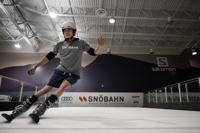

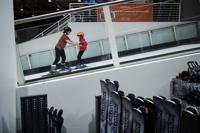



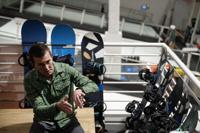



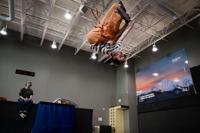

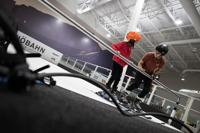

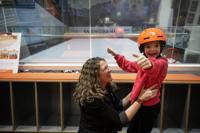

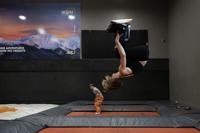

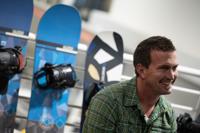

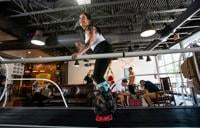
 Your Privacy Choices
Your Privacy Choices